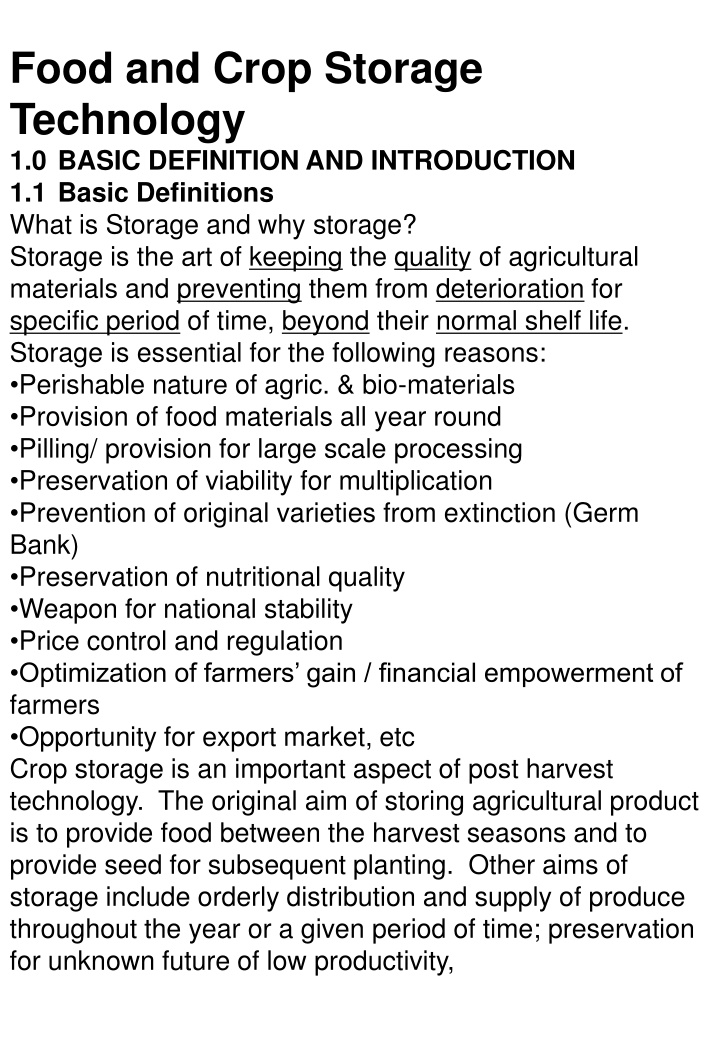
Food and Crop Storage Technology: Basics and Importance
Learn about the fundamentals of food and crop storage technology, including definitions, reasons for storage, and classifications of storage types based on duration and scale. Discover the essential role of storage in preserving agricultural materials, ensuring food security, maintaining quality, and empowering farmers economically.
Download Presentation

Please find below an Image/Link to download the presentation.
The content on the website is provided AS IS for your information and personal use only. It may not be sold, licensed, or shared on other websites without obtaining consent from the author. If you encounter any issues during the download, it is possible that the publisher has removed the file from their server.
You are allowed to download the files provided on this website for personal or commercial use, subject to the condition that they are used lawfully. All files are the property of their respective owners.
The content on the website is provided AS IS for your information and personal use only. It may not be sold, licensed, or shared on other websites without obtaining consent from the author.
E N D
Presentation Transcript
Food and Crop Storage Technology 1.0 BASIC DEFINITION AND INTRODUCTION 1.1 Basic Definitions What is Storage and why storage? Storage is the art of keeping the quality of agricultural materials and preventing them from deterioration for specific period of time, beyond their normal shelf life. Storage is essential for the following reasons: Perishable nature of agric. & bio-materials Provision of food materials all year round Pilling/ provision for large scale processing Preservation of viability for multiplication Prevention of original varieties from extinction (Germ Bank) Preservation of nutritional quality Weapon for national stability Price control and regulation Optimization of farmers gain / financial empowerment of farmers Opportunity for export market, etc Crop storage is an important aspect of post harvest technology. The original aim of storing agricultural product is to provide food between the harvest seasons and to provide seed for subsequent planting. Other aims of storage include orderly distribution and supply of produce throughout the year or a given period of time; preservation for unknown future of low productivity,
and price control or stabilization. Storage has greatly helped farmers to run their farm at a profit. During harvest seasons, supply is higher than consumption and price falls. Storage also aims at reducing unnecessary field losses. Storage could also be a means of maintaining quality and a high nutritional value of food, especially cereal. Typical storage facilities in the tropics mostly provide short term storage. This is because of the subsistent farming pattern and the quantity produced by individual farmer is small. The bi-modal rainfall pattern also contributes to the storage problem. The relative humidity is high at the period of harvest. Ibadan, for example, early maize is harvested between June and July while late maize is harvested between November and December. The relative humidity during these periods is between 72 84% while the environmental temperature is between 26-30oC. These climate conditions are not adequate for the traditional method of storage practiced by most farmers. 1.2 Nature of Agric./ Bio-materials in Relation to Storage Agric./ bio-material have the following characteristics/ nature in relation to storage: Living organism Moisture rich Ripening process Bio degradable Hygroscopic: Shrinkage and swelling occur 2.0 CLASSIFICATIONS OF THE TYPES STORAGE Classification of storage types can be based on the following factors: Duration of Storage
products) are naturally stored for short term. High loss of quality is associated with highly perishable crops in this storage except controlled systems are used. Medium term storage involves keeping the quality of stored products without appreciable deteriorations for up to 12 months. The quality of such stored products may not be guaranteed after 18 months. Long term storage can guarantee the quality of stored products beyond 5 years. Germ banks and some storage systems are known to preserve viability and proximate characteristics of stored materials for decades. 2.2 Classification Based on Scale of Storage Storage systems are classified in terms of size or scale of storage as: Small Scale Storage Medium Scale Storage Large Scale Storage Small scale storage systems have capacity for up to 1 ton, but not beyond. They are mostly used at domestic and peasant levels. They are associated with peasant farmers with small farm holdings. Medium scale storage can accommodate up to a hundred tons of stored products. Most of such storage systems are in the capacity range of 2 50 tons, with very few
2.3 Classification Based on Principle of Operation of the Storage System torage systems can be classified in terms of principle of operation. These include: Physical Storage Chemical Storage Biological Storage Physical storage utilizes physical principles to achieve storage and preservation the quality of stored products. The physical environment (in terms of moisture content, temperature and relative humidity) within the storage system is mostly controlled or manipulated to retard the activities of agents of deterioration or prevent deterioration. Example include cold storage and controlled environment. Chemical storage utilizes chemicals to stop or retard the activities of agents of deterioration. The use of chemicals such as wax, atelic, or phosphosene dust or tablet to prevent respiration or insect infestation in stored produce are examples. Some chemicals are however poisonous and their uses must be highly monitored, e.g. phosphosene. Biological storage utilizes biological agents, especially micro organism, to stop or retard the activities of agents of deterioration or enhance











